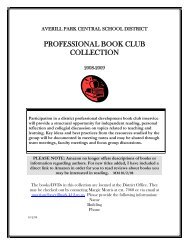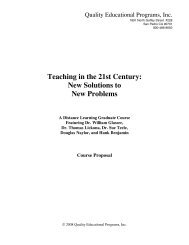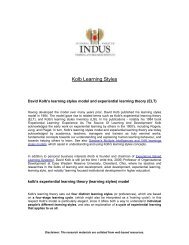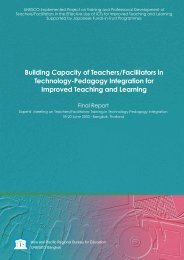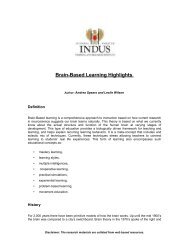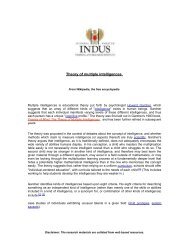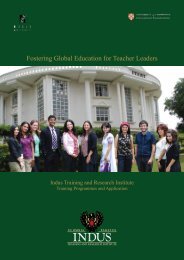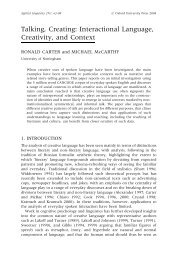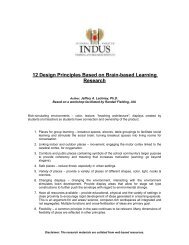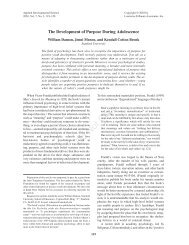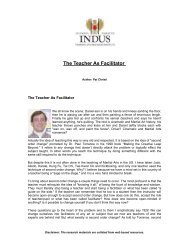Primary Years Programme Making the PYP happen - ITARI
Primary Years Programme Making the PYP happen - ITARI
Primary Years Programme Making the PYP happen - ITARI
- No tags were found...
Create successful ePaper yourself
Turn your PDF publications into a flip-book with our unique Google optimized e-Paper software.
<strong>Making</strong> <strong>the</strong> <strong>PYP</strong> <strong>happen</strong><br />
Good science and technology practice<br />
What is a <strong>PYP</strong> science and technology classroom like<br />
The <strong>PYP</strong> science and technology classroom provides an environment which stimulates and challenges<br />
students’ ideas. A variety of objects, materials and students’ models is displayed at student height around <strong>the</strong><br />
room. Display boards show examples of students’ work and relevant posters illustrate specific science topics.<br />
The class library contains a variety of well illustrated reference books at a wide range of reading levels. On<br />
<strong>the</strong> shelves is an extensive range of equipment for collecting, observing, measuring, recording and presenting<br />
data. The students show enthusiasm and work cooperatively in investigating and experimenting.<br />
How does a <strong>PYP</strong> science and technology classroom work<br />
In <strong>the</strong> <strong>PYP</strong> science and technology classroom, students are engaged in open-ended inquiry through <strong>the</strong><br />
following.<br />
Formulating questions:<br />
Students identify something <strong>the</strong>y want or need to know about <strong>the</strong> biological or physical world. They<br />
learn that <strong>the</strong>ir own questions can be <strong>the</strong> impetus for inquiry. They recognize that new questions<br />
and problems arise all <strong>the</strong> time as we observe and collect data.<br />
Observing:<br />
Students use all <strong>the</strong> senses, touching, feeling, listening, tasting and smelling, as well as seeing, to<br />
notice relevant details of objects or events, resulting in a widening and deepening understanding of<br />
<strong>the</strong> biological and physical world. They choose and use equipment appropriately, to enhance<br />
observation.<br />
Planning:<br />
Students state questions, identify problems, predict, hypo<strong>the</strong>size and justify. They devise ways of<br />
finding out needed information and design experiments and fair tests. They identify ways that<br />
findings can be checked and verified.<br />
Collecting data:<br />
Students ga<strong>the</strong>r data from a variety of sources. They continually question, re-test and check data,<br />
looking for confirmation or ambiguity. They learn to respect evidence which results from <strong>the</strong>ir efforts.<br />
Recording data:<br />
Students describe and record observations with precision and relevant detail, by drawing, note taking,<br />
making charts, tallying and writing statements.<br />
Organizing data:<br />
Students sort, categorize and order information and arrange it into a variety of suitable forms, such<br />
as narrative descriptions, tables, timelines, graphs and diagrams.<br />
Interpreting data:<br />
Students seek for patterns and relationships among scientific phenomena, drawing conclusions and<br />
inferences from relationships and patterns which emerge from organized data. They see new<br />
possibilities in <strong>the</strong> data. They modify earlier hypo<strong>the</strong>ses or explanations in <strong>the</strong> light of new data and<br />
respect reason. They test earlier ideas against new evidence and speculate and hypo<strong>the</strong>size, moving<br />
towards <strong>the</strong> construction of <strong>the</strong>ories about <strong>the</strong> natural world.<br />
Presenting research findings:<br />
Students effectively communicate <strong>the</strong> solutions to problems, <strong>the</strong> answers to questions or <strong>the</strong><br />
evidence for a conclusion. They choose appropriate media. They are honest, presenting information<br />
objectively with supporting evidence.<br />
© IBO 2000 81



